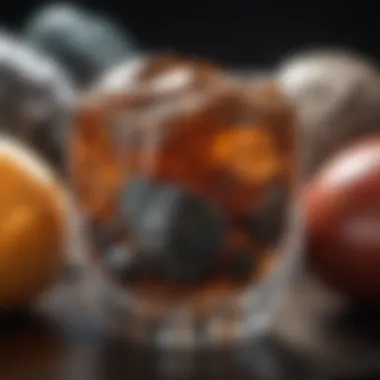Unveiling the Intriguing Universe of Tumblers: An In-Depth Manual for Rock and Fossil Enthusiasts


Rock and Fossil Identification
Tumblers are indispensable tools for rock and fossil collectors, aiding enthusiasts in polishing and revealing the hidden beauty of geological specimens. Understanding the types of rocks and fossils is crucial in recognizing the materials that can benefit from tumbling processes. For rocks, classifications range from igneous, sedimentary, to metamorphic, each boasting unique characteristics waiting to be enhanced. Fossils, on the other hand, present a distinct set of features, such as imprints, casts, or petrified remains, necessitating different tumbling methods. Rock and fossil collectors rely on specific tools for identification, such as magnifying glasses for close examination, UV lights for fluorescence tests, and hardness picks to determine mineral composition.
Introduction to Tumblers
In the vast realm of rock and fossil collecting, tumblers stand out as indispensable tools that aid enthusiasts in enhancing the beauty of their geological finds. Tumblers play a pivotal role in the process of polishing and refining rocks and fossils to reveal their inherent splendor. Understanding the nuances of tumblers is crucial for those passionate about geological artifacts, as these devices have revolutionized the way collectors approach their treasures.
Definition of a Tumbler
Types of Tumblers
Tumblers come in various types, each tailored to specific rock and fossil tumbling needs. From rotary tumblers that offer a thorough, consistent polish to vibratory tumblers that excel in surface refinement, the types of tumblers available cater to different textures and materials. The choice of tumbler type depends on factors such as the desired finish, the hardness of the specimens, and the efficiency of the tumbling process. Understanding the distinct characteristics of each tumbler type allows collectors to select the most suitable equipment for their unique collection requirements.
Purpose of Using a Tumbler
Benefits of Tumblers in Rock and Fossil Collecting
The utilization of tumblers in rock and fossil collecting brings forth a multitude of benefits, elevating the collector's experience. Tumblers aid in achieving a polished finish that highlights the intricate details of specimens, enhancing their aesthetic appeal. Moreover, tumblers expedite the tumbling process, saving collectors valuable time while ensuring consistent results. The use of tumblers also minimizes manual labor, reducing the effort required for polishing and refining rocks and fossils. By simplifying and streamlining the tumbling process, these devices enable collectors to focus on the creative aspect of curating their collections.
History of Tumblers
Evolution of Tumblers in Geology
The evolution of tumblers in geology traces back to the advancement of technology and the growing appreciation for the art of rock and fossil tumbling. Over the years, tumblers have evolved in design and functionality, incorporating features that enhance performance and efficiency. From manual tumbling methods to automated systems, the evolution of tumblers has revolutionized the field of rock and fossil collecting. By understanding the historical development of tumblers, collectors gain valuable insight into the progression of tumbling techniques and the impact of technological innovations on the practice.
Understanding Tumbler Mechanisms


Understanding Tumbler Mechanisms holds a pivotal role in this comprehensive guide, offering valuable insights into the internal workings of these essential tools for rock and fossil collectors. By delving into the mechanisms that drive tumblers, enthusiasts can grasp the intricate processes involved in transforming rough stones and fossils into polished treasures. Understanding Tumbler Mechanisms sheds light on the scientific principles underlying the tumbling process, emphasizing the importance of selecting the right type of tumbler for specific materials and desired results. This section acts as a cornerstone for rock and fossil collectors, empowering them to make informed decisions and optimize their tumbling experience.
Components of a Tumbler
Barrel, motor, and other essential parts constitute the heart of a tumbler's functionality. The barrel serves as the vessel where rocks and abrasives interact, creating the friction necessary for polishing. The motor drives the tumbling action, ensuring consistent rotation or vibration for uniform results. Other essential parts, such as bearings and sealing mechanisms, maintain smooth operation and prevent leaks. The synergy between these components dictates the efficiency and effectiveness of the tumbling process, making each element crucial for achieving desired outcomes in rock and fossil polishing.
Barrel, Motor, and Other Essential Parts
The barrel, motor, and other vital components of a tumbler play integral roles in the tumbling process. The barrel's durable construction withstands the abrasive materials and constant motion, providing a secure environment for rocks to undergo polishing. The motor's power and reliability dictate the tumbling speed and intensity, impacting the efficiency of the polishing action. Other essential parts, like noise-reducing features or automatic shutoff mechanisms, enhance user experience and safety while operating the tumbler. Understanding the functions and characteristics of these components is fundamental for selecting a tumbler that aligns with the specific needs and preferences of rock and fossil collectors.
How Tumblers Work
Rotary and vibratory tumblers represent two distinct mechanisms employed in rock and fossil polishing. Rotary tumblers utilize a rotating barrel to tumble rocks, applying abrasives gradually for a thorough polishing process. In contrast, vibratory tumblers rely on rapid vibrations to achieve polishing, offering quicker results with minimal material usage. Each tumbler type presents unique advantages and limitations, catering to varying preferences among rock and fossil enthusiasts. By understanding how these tumblers operate, collectors can choose the most suitable option based on their desired outcome and operational preferences.
Rotary and Vibratory Tumblers
Distinguishing between rotary and vibratory tumblers is crucial for rock and fossil collectors seeking optimal results in polishing. Rotary tumblers excel in handling larger batches of rocks and providing a smoother finish due to their constant rotation. In contrast, vibratory tumblers offer faster processing times and reduced material consumption, making them ideal for beginners or shorter tumbling cycles. Evaluating the advantages and disadvantages of both types enables collectors to make informed decisions that align with their specific rock, fossil, and polishing requirements.
Common Issues and Maintenance
Troubleshooting tips and care practices play a vital role in ensuring the longevity and performance of tumblers in rock and fossil collecting. Addressing common issues like barrel leaks, motor malfunctions, or abrasive wear enhances the tumbler's efficiency and prolongs its lifespan. Implementing regular maintenance routines, such as barrel cleaning, motor lubrication, and part inspections, minimizes downtime and optimizes the tumbler's operational capabilities. By familiarizing themselves with troubleshooting protocols and maintenance guidelines, rock and fossil enthusiasts can mitigate potential challenges and maximize the productivity of their tumbling endeavors.
Troubleshooting Tips and Care Practices
Effective troubleshooting methods and diligent care practices are essential for maintaining optimal tumbler performance in rock and fossil collecting. Conducting routine checks on the barrel seals, motor integrity, and abrasive levels helps identify and address potential issues before they escalate. Utilizing appropriate lubricants, cleaning agents, and replacement parts ensures smooth operation and prevents premature wear. Incorporating these best practices into a regular maintenance routine preserves the tumbler's functionality and safeguards its effectiveness throughout the rock and fossil polishing process.
Choosing the Right Tumbler


In the fascinating realm of rock and fossil collecting, the process of selecting the ideal tumbler holds significant importance. Rock and fossil enthusiasts understand that choosing the right tumbler can greatly impact the efficiency and quality of their tumbling experience. This section delves into the crucial factors that individuals need to consider when selecting a tumbler, ensuring that their investment aligns with their specific needs and preferences.
Factors to Consider
Noise levels, capacity, and durability
When it comes to choosing the right tumbler, factors such as noise levels, capacity, and durability play a pivotal role in the overall satisfaction of the user. Noise levels can affect the user experience, with quieter tumblers often being more favorable for individuals seeking a less disruptive tumbling process. Capacity is another key consideration, as it determines the amount of rocks or fossils that can be tumbled at once, impacting the efficiency of the tumbling process. Additionally, durability is essential for long-term usage, ensuring that the tumbler can withstand regular wear and tear.
Emphasizing noise levels, capacity, and durability in the selection process is vital for rock and fossil collectors aiming for optimal tumbling results. Quieter tumblers provide a more serene tumbling environment, allowing enthusiasts to focus on the intricate transformations taking place within the barrel. High-capacity tumblers cater to those looking to tumble larger batches of specimens, streamlining the tumbling process for efficiency. Furthermore, durable tumblers offer longevity and robustness, enabling users to engage in tumbling activities with confidence and reliability.
Best Tumbler Brands
Top recommendations for rock and fossil enthusiasts
Delving into the realm of tumbler brands, rock and fossil enthusiasts are presented with a plethora of choices catering to their needs and preferences. Top tumbler brands prioritize quality, functionality, and performance, offering users a seamless tumbling experience. In this section, we explore the top recommendations for rock and fossil enthusiasts, outlining the key characteristics that set these brands apart in the competitive market.
Top tumbler brands recommended for rock and fossil enthusiasts are distinguished by their exceptional build quality, innovative designs, and user-friendly features. These brands prioritize the needs of collectors, offering tumblers that deliver consistent results and enhanced user satisfaction. The unique feature of these top brands lies in their ability to combine cutting-edge technology with user-focused design, resulting in tumblers that streamline the tumbling process and deliver remarkable polishing and shaping outcomes.
Budget-Friendly Options
Quality tumblers at affordable prices
For enthusiasts exploring budget-friendly options without compromising on quality, affordable tumbler choices are available in the market. These budget-friendly options cater to individuals seeking cost-effective solutions for their tumbling needs, opening up avenues for more enthusiasts to engage in the captivating world of rock and fossil tumbling.
Quality tumblers at affordable prices offer collectors the opportunity to experience the benefits of tumbling without breaking the bank. These tumblers exhibit excellent craftsmanship, reliable performance, and durability at a fraction of the cost of premium models. The unique feature of budget-friendly tumblers lies in their ability to provide a cost-effective entry point for beginners and seasoned collectors alike, making the tumbling experience accessible to a wider audience.
Utilizing Tumblers in Rock and Fossil Collecting


The Importance of Utilizing Tumblers in Rock and Fossil Collecting
In the realm of rock and fossil collectors, the use of tumblers holds immense significance. These tools play a pivotal role in the preparation and enhancement of geological specimens, allowing enthusiasts to unlock the hidden beauty within rocks, minerals, and fossils. Utilizing tumblers in the collection process is not only about aesthetics but also improves the overall quality and presentation of the specimens. It enables collectors to polish rough surfaces, reveal intricate patterns, and achieve a professional finish that showcases the true essence of each specimen. By delving into the art of tumbling, collectors can elevate their collections to a whole new level, adding a touch of sophistication and allure to their treasures.
Preparing Specimens for Tumbling
Cleaning, Shaping, and Polishing Rocks and Fossils
The meticulous process of cleaning, shaping, and polishing rocks and fossils is a fundamental aspect of preparing specimens for tumbling. This particular phase holds paramount importance as it sets the foundation for achieving impeccable results during the tumbling process. By meticulously cleaning each specimen, collectors can ensure that surface impurities are removed, allowing for a more uniform polishing outcome. Shaping the rocks and fossils not only enhances their visual appeal but also aids in achieving the desired final form that highlights their unique features. Polishing, the final step in this preparatory stage, refines the surfaces, bringing out the natural luster and beauty of the specimens. The integrated approach of cleaning, shaping, and polishing ensures that each specimen is primed for the tumbling process, guaranteeing optimal results that meet the highest standards of quality.
Tumbling Techniques
Step-by-Step Guide to Achieving Optimal Results
Navigating the tumbling process requires a systematic approach that maximizes the potential of each specimen. The step-by-step guide to achieving optimal results serves as a roadmap for collectors, outlining the precise actions needed to transform rough rocks and fossils into exquisite treasures. Beginning with selecting the appropriate grit size for the initial tumbling stages, collectors gradually progress through finer grits to refine the surfaces and achieve a smooth finish. Understanding the rotation speed, tumbling duration, and material ratios are crucial in determining the outcome of the tumbling process. By following this comprehensive guide meticulously, collectors can master the art of tumbling, unlocking the hidden beauty of their specimens with precision and expertise.
Safety Measures
Protective Gear and Precautions for Using Tumblers
Embracing safety measures when using tumblers is paramount to ensure a secure and productive tumbling experience. Equipping oneself with protective gear, such as safety glasses and gloves, safeguards against potential hazards, such as flying particles or chemical splashes during the tumbling process. Additionally, observing precautions, such as working in well-ventilated areas and maintaining the tumbler on stable surfaces, enhances operational safety and minimizes risks of accidents. Prioritizing safety not only protects collectors from harm but also promotes a smooth and efficient tumbling process, allowing individuals to focus on achieving outstanding results with peace of mind.
Conclusion
In the vast landscape of rock and fossil collecting, the significance of tumblers emerges as a crucial player in enhancing collections. Tumblers play a pivotal role in refining the texture and appearance of rocks and fossils, elevating their aesthetic appeal and value. By utilizing tumblers, enthusiasts can achieve polished and gleaming specimens that showcase the inherent beauty of geological treasures. Furthermore, tumblers facilitate the process of cleaning and shaping stones, streamlining the overall collecting experience for individuals deeply immersed in this hobby.
Enhancing Your Collection with Tumblers
Summarizing the importance of tumblers in rock and fossil collecting
Delving into the crux of rock and fossil collecting, the importance of tumblers becomes evident in their ability to transform raw specimens into refined treasures. One key aspect of tumblers lies in their power to bring out the intrinsic beauty of rocks and fossils, unveiling details and patterns that may otherwise remain hidden. This efficiency in polishing and shaping materials not only adds visual allure to collections but also aids in preserving the integrity of delicate specimens.
Moreover, the consistent results delivered by tumblers streamline the preparation process, allowing collectors to achieve professional-grade finishes with relative ease. For enthusiasts seeking to showcase their finds with pride, tumblers serve as indispensable tools in achieving polished, exhibition-worthy pieces. Despite their mechanical nature, tumblers offer a touch of artistry to the realm of rock and fossil collecting, bridging the gap between raw discoveries and refined artifacts.







